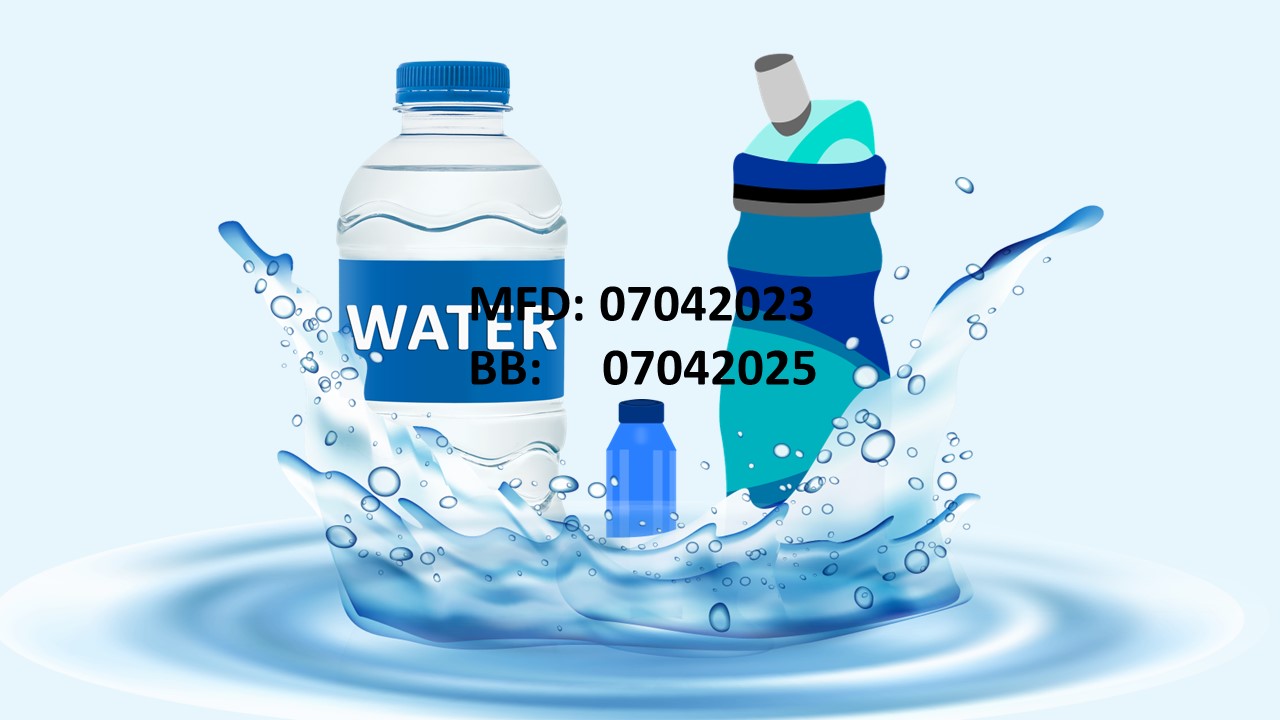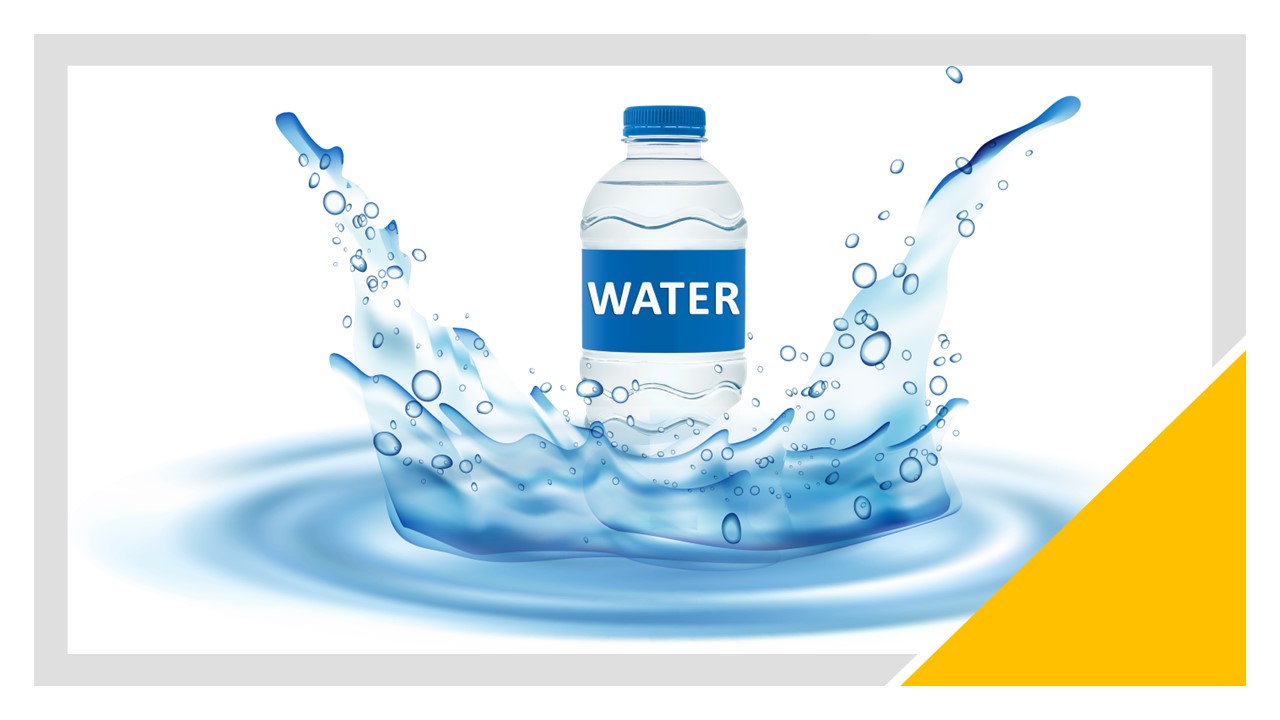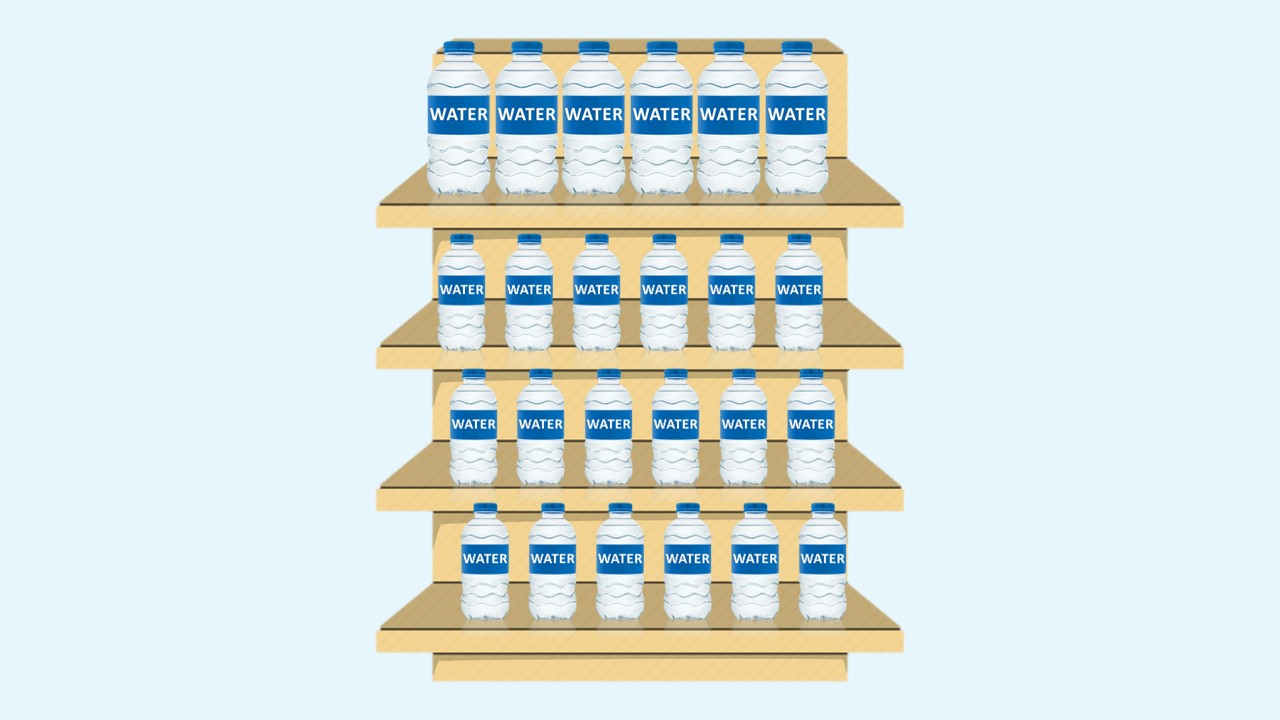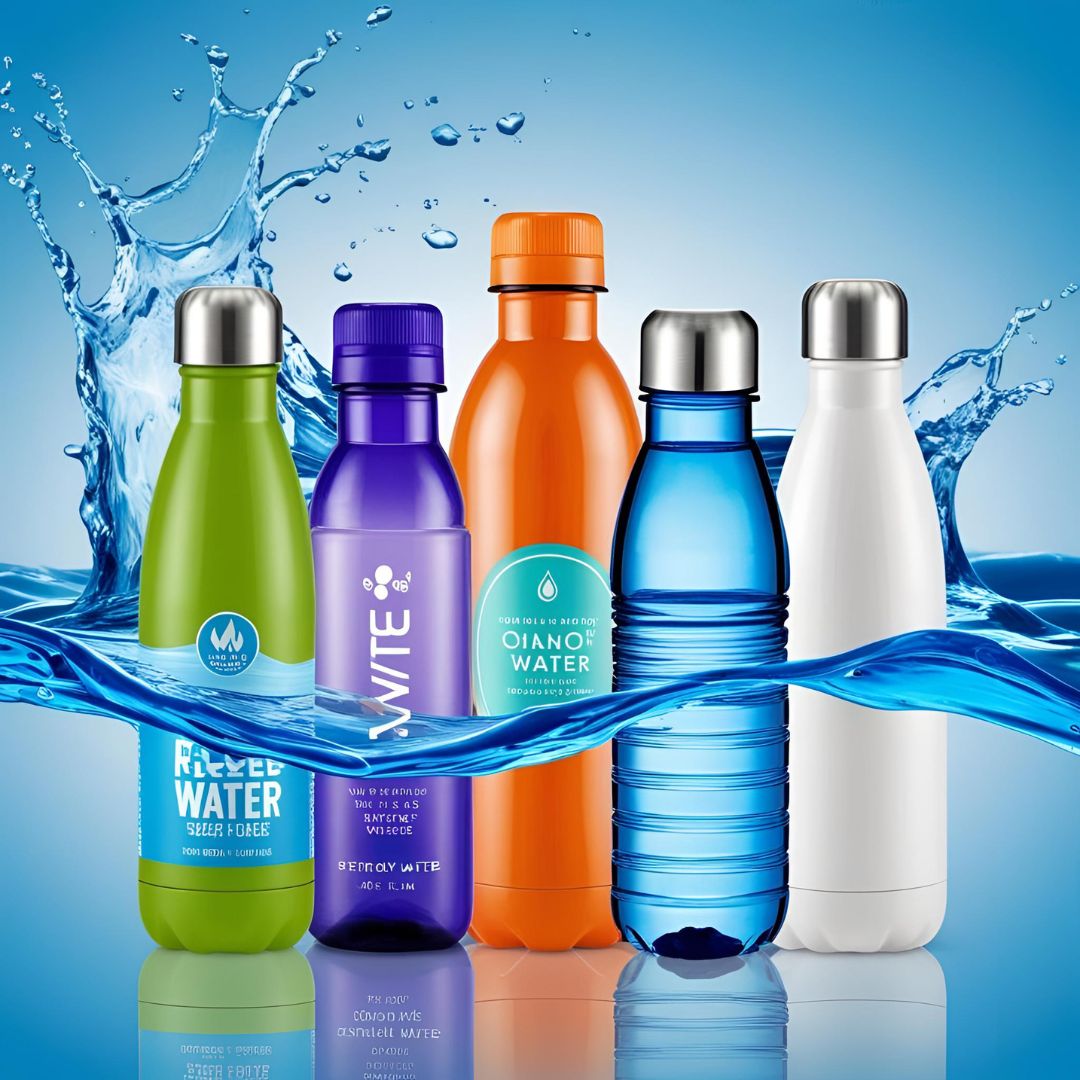What Is BPA Free Water Bottles – Should You Be Worried?
What is BPA free water bottles? BPA-free water bottles are plastic water bottles without traces of BPA (bisphenol A). BPA-free water bottles are certified safe for beverages and food containers and they usually come with a BPA-free logo.
BPA-free water bottles do not leach harmful chemicals into beverages and food like BPA plastic which is why they are generally accepted as safe for use. BPA is a known chemical that should not be consumed by humans as it can cause a lot of health problems.
This blog post will explain everything you need to know about BPA, BPA-free water bottles and how to identify BPA-free water bottles to avoid health hazards that can be brought about by plastic containing BPA. Read on.
Related: Why Are There Bubbles In My Water Bottle
What Is BPA Free Water Bottles
BPA-free water bottles are water bottles made from materials that do not contain Bisphenol A (BPA). BPA is a chemical commonly used in certain plastics and is known to have potential health risks, particularly as an endocrine disruptor.
BPA-free water bottles are considered safer alternatives, as they eliminate the risk of exposure to this chemical. These bottles are designed to provide a safer and healthier way to stay hydrated while reducing concerns related to harmful chemical leaching.
BPA-free water bottles have gained popularity as a safer choice for individuals concerned about their health and the environment. With growing awareness of the potential health risks associated with BPA exposure, many people are opting for BPA-free alternatives to reduce their exposure to this chemical.
BPA, a synthetic compound used in the production of certain plastics, can leach into food and beverages when the plastic comes into contact with hot liquids or undergoes wear and tear.
Research has linked BPA to various health concerns, including hormone disruption, reproductive issues, and other potential adverse effects on human health.
To address these concerns, manufacturers have developed BPA-free water bottles using alternative materials like stainless steel, glass, Tritan™ copolyester, or high-density polyethylene (HDPE).
These materials provide safe and non-toxic hydration options, eliminating the risk of BPA leaching into drinks and posing potential health risks.
In addition to the health benefits, BPA-free water bottles contribute to environmental conservation by promoting a shift away from single-use plastic bottles.
By choosing reusable BPA-free options, individuals can reduce plastic waste, help alleviate the burden on landfills, and minimize plastic pollution in oceans and natural environments.
Moreover, BPA-free water bottles come in a wide variety of shapes, sizes, and designs, catering to different preferences and lifestyles. Whether it’s for sports activities, outdoor adventures, or daily hydration, there’s a suitable BPA-free water bottle to meet every individual’s needs.
What Is The Best BPA-Free Water Bottles? (What Is BPA Free Water Bottles)
While there are different bottles out there that claim to be BPA-free, there are bottles that are truly BPA-free. If you are looking for a genuinely BPA-free water bottle for use without other harmful chemicals, here are the best:
Product Image | Product Name | Key Features | Rating | Price |
| ||||
| ||||
| ||||
| ||||
| ||||
| ||||
| ||||
| ||||
| ||||
|
All the bottles on the list are safe to use, durable, gorgeous and easy to clean. They easily keep your liquid in the right temperature and are perfect for all-day activities.
What Is BPA? – Should You Be Worried About BPA?
BPA, or bisphenol A, is a synthetic chemical used in the production of certain plastics and epoxy resins because of its properties such as lightweight, toughness, heat resistance, transparency and electrical resistance.
It is widely used in a variety of consumer products, such as food and beverage containers, water bottles, thermal paper, and more. Epoxy resin is used in coating the inside of metal products such as water supply lines, bottle tops and food cans.
Although BPA is considered safe by most regulatory agencies such as FDA when consumed in small quantities, there is some concern about its potential health effects.
Animal studies have shown that BPA exposure can disrupt the endocrine system, and there is some evidence that it may also be linked to reproductive problems, obesity, and cancer. However, more research is needed to confirm these potential health risks.
If you are concerned about BPA exposure, there are a few ways you can reduce your exposure. When possible
- Choose BPA-free products
- Avoid putting plastic in the dishwasher or microwave because heat can break them down and can result in BPA leaching into your food
- You can also avoid thermal paper receipts, which often contain BPA.
- Eat your food fresh when you can
- Use stainless steel, porcelain or glass for hot liquids and foods rather than plastic containers.
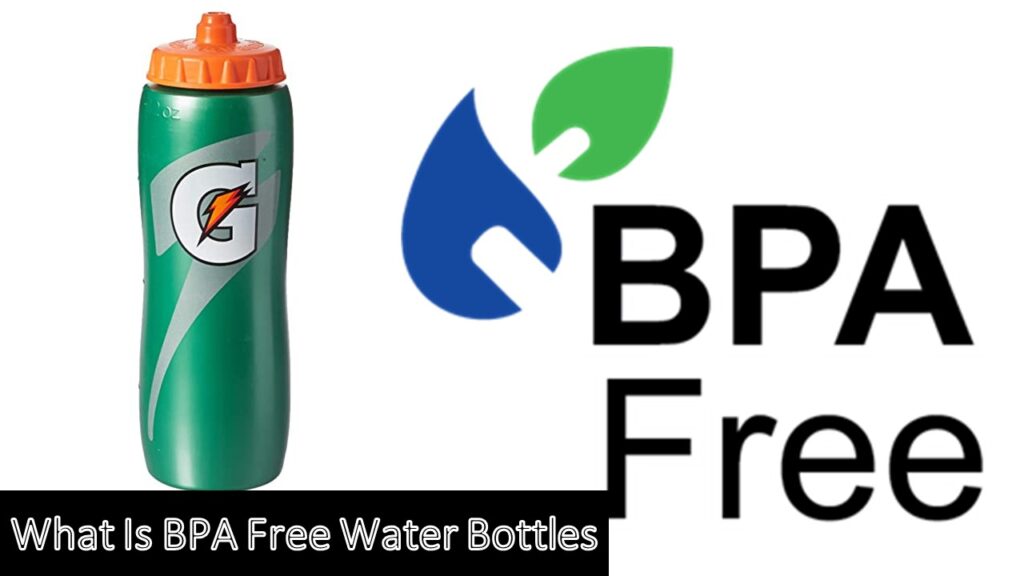
How Bad Is BPA In Water Bottles (What Is BPA Free Water Bottles)
Studies show that BPA is toxic and can affect both the reproductive system and the human brain. It has also been said to cause fertility problems and possibly miscarriage in women. BPA is also said to cause behavioral problems in children, increased risk of diabetes and heart disease in adults.
How To Tell If A Water Bottle Is BPA Free?
There are a few ways to tell if bottled water is BPA-free. Some of the ways to tell include avoiding bottles with numbers 3. 6 and 7 recycling codes, and bottles with epoxy liners or polycarbonate. Also, if your water tastes weird, you should check your bottle.
BPA-free bottles are bottles with codes 1, 2, 4 or 5. Here is what each code means:
Code 1: This means the plastic is made with PET (polyethylene terephthalate) which is considered safe. PET is usually used for condiment containers, food jars and water bottles. Plastics made with PET are meant for single use to avoid increasing the risk of bacterial growth and BPA leaching.
Code 2. Bottle with code 2 is made with HDPE (high density polyethylene) which is considered fairly safe. HDPE is used in bottle crates, water jugs and cosmetics bottles.
Code 3. Bottles with code 3 are made with PVC (polyvinyl chloride) which is not BPA-free. PVC is usually found in door frames, shower curtains and drainage pipes, so if it is used to make a plastic bottle, avoid it completely.
Code 4: Bottles with code 4 are made with LDPE (low density polyethylene) considered to be relatively safe for use. Code 4 is found in squeezable bottles, bread wrapping and grocery bags.
Code 5: Bottles with code 5 are made with PP (polypropylene) which offers great heat resistance properties. Code 5 plastics are BPA-free and safe to use.
Code 6: Bottles with code 6 contain PS (polystyrene_ which is an ultra-lightweight material. Though code 6 bottles are free of BPA, polystyrene may leach into your liquid because it is structurally weak.
Code 7: Bottles with code 7 are BPA plastic and you should avoid these types of bottles if you are worried about BPA.

How To Avoid BPA? (What Is BPA Free Water Bottles)
The best way to avoid BPA is to ditch bottles made with BPA materials for bottles made with BPA-free materials. You should also limit your intake of canned products. You should also avoid placing plastic bottles in the microwave and dishwasher because heat can cause BPA to leach into your liquid.
BPA-Free Water Bottle Benefits (What Is BPA Free Water Bottles)
When it comes to choosing a water bottle, there are many options available on the market. But one type of water bottle that is becoming increasingly popular is the BPA-free water bottle. BPA-free water bottles are made without the use of bisphenol A (BPA), a chemical that has been linked to a variety of health concerns.
So why choose a BPA-free water bottle? There are a few key benefits that make them a great choice for both you and the environment.
- BPA-free water bottles are free of harmful chemicals
- They are durable and long-lasting
- They are recyclable.
- They are eco-friendly
- They are less likely to leach chemicals into your liquid
- They are healthier for everyone including children
If you are looking for a safe and eco-friendly water bottle option, a BPA-free water bottle is a great choice.
RELATED: Does Water Bottles Expire
The Drawbacks Of Using BPA-Free Water Bottles
Here are some potential drawbacks to consider:
1. Higher cost: BPA-free water bottles, especially those made from alternative materials like stainless steel or glass, can be more expensive than traditional plastic bottles. This higher cost may deter some budget-conscious consumers from making the switch.
2. Durability and fragility: Certain BPA-free materials, such as glass, may be more fragile and prone to breaking when dropped or mishandled, making them less suitable for some outdoor or active lifestyles.
3. Limited availability: BPA-free water bottles may not be as readily available as conventional plastic bottles, especially in some regions or stores. This limited availability could pose challenges for consumers seeking to make the switch.
4. Potential for other harmful chemicals: While BPA is removed from BPA-free bottles, some alternative materials or manufacturing processes used in these bottles may introduce other potentially harmful chemicals.
For example, some plastics labeled as BPA-free may contain other endocrine-disrupting chemicals or substances of concern.
5. Environmental impact: Though BPA-free bottles are marketed as more eco-friendly, some materials used in their production, like certain types of plastics or coatings, can still have adverse environmental effects. Proper disposal and recycling of BPA-free bottles are essential to minimize their environmental impact.
6. Retaining flavors and odors: Some BPA-free materials might retain flavors or odors from previous beverages, affecting the taste of the water and potentially discouraging users from reusing the bottle.
7. Lack of long-term studies: While BPA’s health risks are well-documented, the long-term health effects of using BPA-free materials are not yet fully understood. Limited research on these alternative materials may raise questions about their safety over extended periods of use.
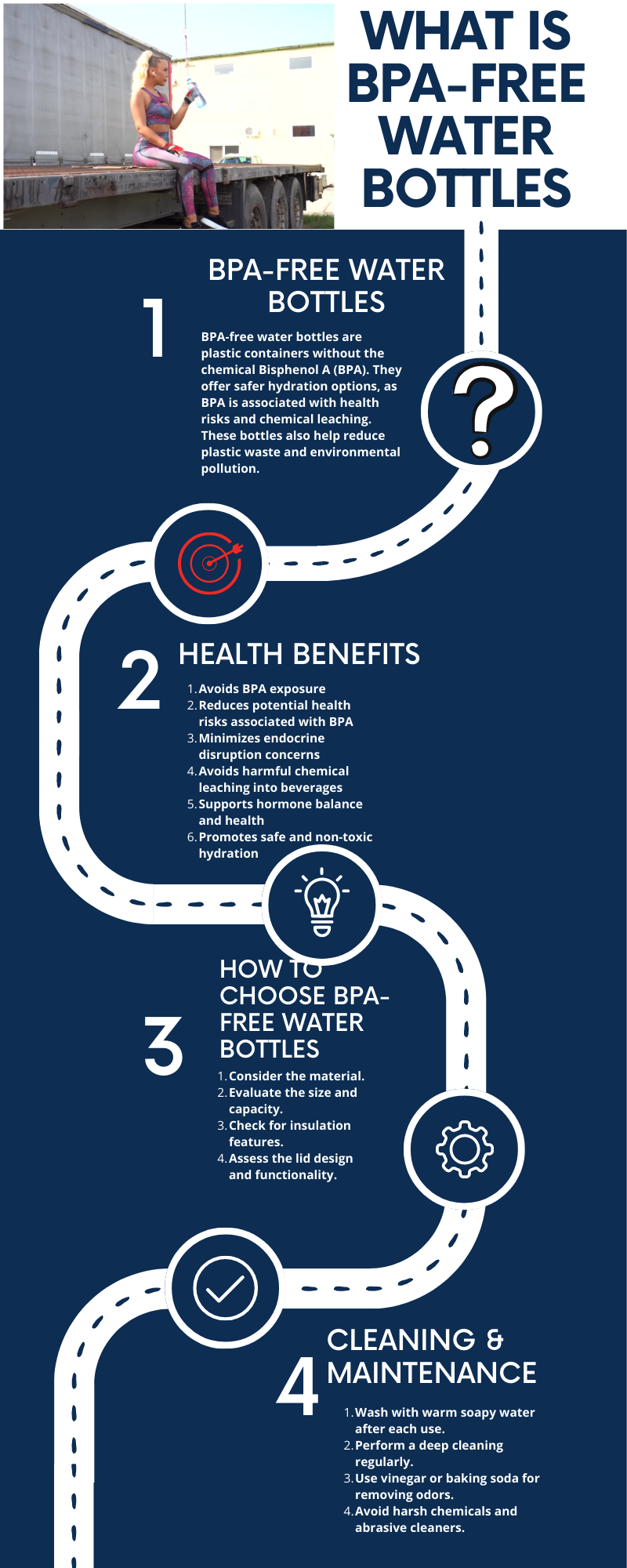
Tips And Guidelines For Selecting The Most Suitable BPA-Free Water Bottle
When choosing the right BPA-free water bottle, you should consider various factors to ensure the bottle meets your needs and preferences. Here are some tips and guidelines to help you make an informed decision:
1. Material options: BPA-free water bottles are available in various materials, such as stainless steel, glass, Tritan™ copolyester, or high-density polyethylene (HDPE). Each material has its pros and cons. For example:
– Stainless steel: Durable, good for keeping beverages hot or cold, but may be heavier.
– Glass: Environmentally friendly, doesn’t retain flavors, but can be fragile.
– Tritan™ copolyester: Lightweight, shatter-resistant, and BPA-free, but may not be suitable for hot liquids.
– HDPE: Lightweight, durable, and more affordable, but may not have the insulating properties of other materials.
2. Size and capacity: Consider the size of the water bottle and its capacity. A larger capacity is ideal for outdoor activities or longer trips, while a smaller one might be more convenient for everyday use.
3. Insulation: If the user wants to keep their beverages hot or cold for extended periods, an insulated BPA-free water bottle might be the best choice.
4. Lid design: Check the lid type and ensure it is easy to open and close securely. Some lids have flip-up straws, while others have screw-on caps or wide-mouth openings.
5. Leak-proof and spill-proof features: Look for bottles with leak-proof or spill-proof designs, especially if the bottle will be used during physical activities or kept in bags.
6. Cleaning and maintenance: Consider how easy it is to clean the water bottle. Bottles with wide openings or removable components are generally easier to clean thoroughly.
7. Compatibility with beverages: If the user plans to use the bottle for various beverages (e.g., water, smoothies, coffee), make sure it is suitable for different types of liquids.
8. Brand reputation and reviews: Research the brands and read customer reviews to gauge the reliability and quality of the BPA-free water bottle.
9. Eco-friendliness: Some BPA-free water bottles are made from more sustainable materials or have eco-friendly production processes. Consumers concerned about the environmental impact should look for such options.
10. Price: Consider the budget and find a BPA-free water bottle that offers the best balance of features and affordability.
11. Warranty and customer support: Check if the bottle comes with a warranty or any customer support, which can be beneficial in case of defects or issues.
Benefits Of Using BPA-Free Water Bottles And Their Role In Reducing Plastic Waste And Pollution
Using BPA-free water bottles offers several environmental benefits, contributing to the reduction of plastic waste and pollution. Here’s an explanation of the environmental advantages:
1. Reduces Single-Use Plastic Waste
BPA-free water bottles are designed for repeated use, reducing the need for single-use plastic bottles. Single-use plastic bottles, often made with BPA-containing plastics, are a significant contributor to plastic waste, leading to overflowing landfills and littered environments.
2. Decreases Plastic Pollution
BPA-free water bottles, especially those made from alternative materials like stainless steel or glass, are more durable and less prone to breakage than traditional plastic bottles.
This durability helps prevent plastic particles from entering the environment and oceans as microplastics, which can have harmful impacts on marine life and ecosystems.
3. Encourages Reusability
Many BPA-free water bottles are designed for long-term use, encouraging consumers to adopt a reusable lifestyle. By reusing a BPA-free bottle instead of purchasing single-use bottles repeatedly, individuals can significantly reduce their plastic waste footprint over time.
4. Promotes Recycling
BPA-free bottles made from recyclable materials, such as certain types of plastic or aluminum, can be recycled at the end of their life cycle. Proper recycling ensures that these materials are diverted from landfills and can be used to create new products, reducing the demand for virgin materials.
5. Supports Sustainable Materials
Some BPA-free water bottles are made from eco-friendly and sustainable materials like stainless steel, which have a lower environmental impact compared to traditional plastic. These materials can be recycled and reused indefinitely, further minimizing their environmental footprint.
6. Limits BPA Contamination
BPA, a chemical found in certain plastics, has been associated with health concerns. By choosing BPA-free water bottles, consumers reduce their exposure to BPA, which can potentially have positive implications for human health and the environment.
7. Promotes Conscious Consumerism
Opting for BPA-free water bottles is a step towards conscious consumerism. When you make eco-friendly choices, it sends a signal to manufacturers and industries that there is demand for sustainable products, encouraging more environmentally friendly practices and innovation.
8. Educates and Raises Awareness
Highlighting the environmental benefits of BPA-free water bottles through marketing and educational campaigns can raise awareness among consumers about the importance of reducing plastic waste and choosing sustainable alternatives.
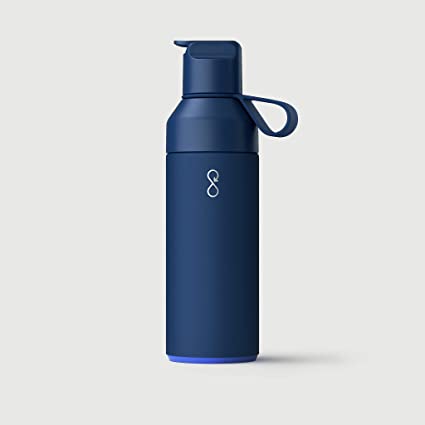
Comparisons Of Different Types Of BPA-Free Water Bottles (What Is BPA Free Water Bottles)
| Material | BPA-Free Plastic | BPA-Free Stainless Steel | BPA-Free Glass | BPA-Free Aluminum |
| Pros | Lightweight and portable | Durable and long-lasting | Non-reactive and doesn’t leach chemicals | Lightweight and portable |
| Affordable | Resistant to dents and scratches | Environmentally friendly and recyclable | Durable and resistant to corrosion | |
| Wide variety of colors and designs | Retains beverage temperature | Elegant and stylish appearance | Retains beverage temperature | |
| Easy to squeeze for drinking | Doesn’t retain or impart flavors | Smooth surface for easy cleaning | Doesn’t retain or impart flavors | |
| Cons | Can retain odors and flavors | Heavier than plastic | Fragile and prone to breakage | Not suitable for hot beverages |
| Not suitable for hot beverages | Can be more expensive than plastic | Heavy and less portable | Limited color and design options | |
| May not be as durable as other materials | May dent or scratch over time | Can be heavy and break if dropped | Can dent and lose shape | |
| Can leach harmful chemicals under extreme conditions | May not keep beverages hot/cold for as long | Can be heavy and break if dropped | Not suitable for hot beverages | |
| Not environmentally friendly | Some designs may have narrow openings, making cleaning difficult | Can break when dropped | May not keep beverages hot/cold for as long | |
| Can deform or degrade under high temperatures | May leach aluminum into beverages |
How To Clean And Maintain BPA-Free Water Bottles
Proper cleaning and maintenance of BPA-free water bottles are essential to ensure their longevity, hygiene, and optimal performance. Follow these instructions to keep your water bottle clean and in good condition:
Regular Cleaning
- Wash the water bottle thoroughly after each use with warm soapy water. Use a mild dish soap and a bottle brush to reach all corners and crevices.
- Rinse the bottle multiple times to ensure no soap residue remains.
- Allow the bottle to air dry completely before putting the cap back on.
Deep Cleaning
- Perform a deep cleaning at least once a week or as needed, especially if you use the bottle for beverages other than water.
- Fill the bottle with a mixture of equal parts white vinegar and water or use a mild solution of baking soda and water.
- Let the solution sit in the bottle for about an hour, then scrub the interior with a bottle brush to remove any buildup or stains.
- Rinse the bottle thoroughly with water to remove the cleaning solution, and air dry completely.
Removing Odors
- If your BPA-free water bottle develops odors, fill it with warm water and a teaspoon of baking soda.
- Let it sit overnight, then rinse and wash as usual. This should help neutralize any lingering odors.
Avoiding Harsh Cleaners
Do not use harsh chemicals, bleach, or abrasive cleaners, as they can damage the bottle’s material and compromise its safety.
Disassembling Removable Parts
- If your water bottle has removable parts such as caps, straws, or seals, disassemble them before cleaning.
- Clean each part separately to ensure thorough hygiene.
Storing Properly
When not in use, store the water bottle with the cap off to allow proper air circulation and prevent moisture buildup.
Avoiding Extreme Temperatures
Avoid exposing the BPA-free water bottle to extreme temperatures, especially if it’s not designed for hot liquids. High temperatures can deform some plastics or cause burns if the bottle becomes too hot to touch.
Regular Inspections
Regularly inspect the bottle for signs of wear, cracks, or leaks. If you notice any damage, consider replacing the bottle to maintain its integrity.
Avoiding Microwave or Freezer
Most BPA-free water bottles are not suitable for microwave use or freezing. Check the manufacturer’s guidelines to ensure you don’t damage the bottle.
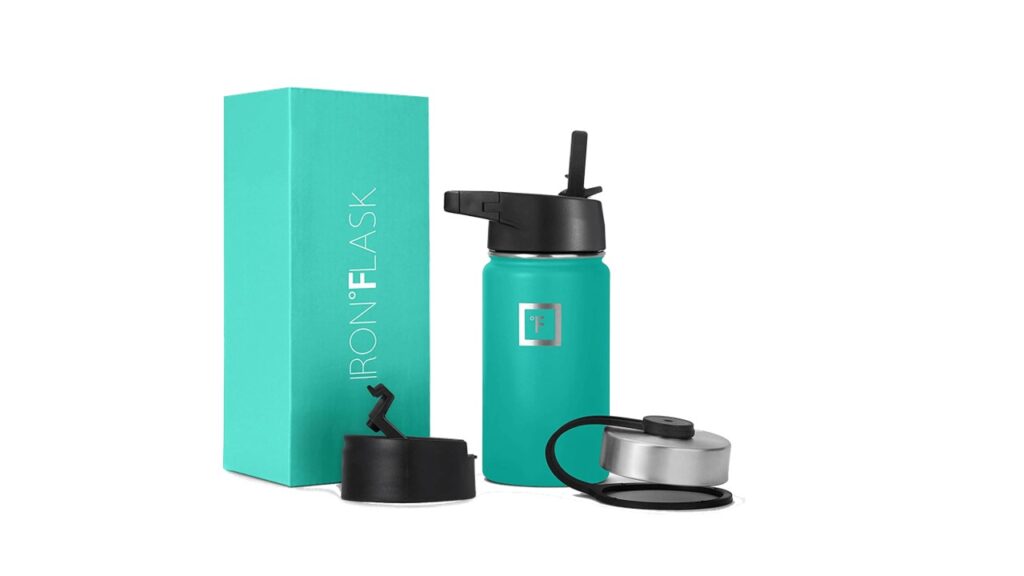
How Long Can You Use A BPA-Free Bottle (What Is BPA Free Water Bottles)
BPA-free bottles are generally durable. For instance, BPA-free plastic bottles can be used for up to 2 years while BPA-free stainless steel bottles can be used for up to 12 years or more. How long to use a BPA-free bottle also depends on the materials and how caring the user is.
RELATED: How To Clean Water Bottles EffectivelyWithout Odor And Stain
Is BPA-Free Plastic Safe? (What Is BPA Free Water Bottles)
Bisphenol A (BPA) is a chemical used in the production of certain plastics. It has been linked to a variety of health concerns, including cancer and endocrine system disruption. As a result, many companies have started producing BPA-free plastics. But is this safer alternative really safe?
Some studies (1 2) have shown that BPA-free plastics may not be any safer than those that contain BPA. In fact, some of them may even be more harmful. This is because BPA-free plastics often contain other chemicals that can be just as dangerous as BPA.
So, BPA-free bottles are different but not necessarily safer.
Frequently Asked Questions (FAQs) On What Is BPA Free Water Bottles
1. What Does “BPA-Free” Mean?
“BPA-free” means the water bottle is free from Bisphenol A (BPA), a chemical often found in certain types of plastics. BPA is known to have potential health risks, and choosing a BPA-free water bottle eliminates exposure to this chemical.
2. Are BPA-Free Water Bottles Safe?
Yes, BPA-free water bottles are generally considered safe for use. The absence of BPA reduces the risk of exposure to this chemical. However, it’s essential to choose reputable brands and materials to ensure the bottles meet safety standards.
3. Which Materials Are Used In BPA-Free Water Bottles?
BPA-free water bottles are made from various materials, including stainless steel, glass, Tritan™ copolyester, and high-density polyethylene (HDPE). Each material has its unique features and benefits.
4. Are BPA-Free Plastic Water Bottles Safe?
BPA-free plastic water bottles are considered safe for use. However, it’s crucial to check for alternative chemicals used in the plastic and opt for bottles labeled as food-safe and meeting safety regulations.
5. Can I Use BPA-Free Water Bottles For Hot Liquids?
Not all BPA-free water bottles are suitable for hot liquids. Check the manufacturer’s guidelines to ensure the bottle can handle hot beverages without deformation or leaching any harmful substances.
6. How Do I Clean BPA-Free Water Bottles?
Clean BPA-free water bottles with warm soapy water after each use. For a deeper clean, use a mixture of vinegar and water or baking soda and water. Avoid harsh chemicals or abrasive cleaners.
7. Are BPA-Free Water Bottles Eco-Friendly?
BPA-free water bottles made from sustainable materials like stainless steel or glass are more eco-friendly than single-use plastic bottles. Look for bottles with eco-friendly manufacturing practices.
8. Do BPA-Free Water Bottles Retain Flavors Or Odors?
Some BPA-free materials, particularly plastic, may retain flavors or odors from previous beverages especially when not cleaned after use. Opt for materials like stainless steel or glass if you want to avoid this issue.
9. How Do I Choose The Right BPA-Free Water Bottle For My Needs?
Consider factors like material, size, insulation, lid design, and compatibility with beverages. Assess your preferences and lifestyle to choose a bottle that best suits your needs.
10. Are BPA-Free Water Bottles Dishwasher-Safe?
Many BPA-free water bottles are dishwasher-safe, but it’s essential to check the manufacturer’s instructions. Some materials or lids may require handwashing for optimal longevity.
11. Can BPA-Free Water Bottles Be Recycled?
BPA-free water bottles made from recyclable materials, like certain plastics or aluminum, can be recycled. Proper recycling helps reduce their environmental impact and supports sustainability.
RELATED: Why Does My Water Bottle Smell Even After Washing – Should You Be Concerned?
The Bottom Line On What Is BPA Free Water Bottles
So, what is BPA free water bottles? BPA-free water bottles are a great way to stay hydrated without exposing yourself to harmful chemicals.
BPA is a synthetic estrogen that can disrupt the endocrine system, and it has been linked to a variety of health problems. There are many different types of BPA-free water bottles available, so be sure to check out the best ones before you buy.










